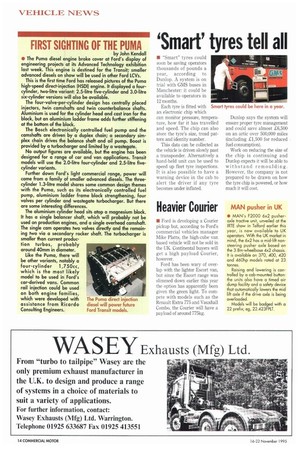FIRST SIGHTING OF THE PUMA
Page 16

If you've noticed an error in this article please click here to report it so we can fix it.
by John Kendall • The Puma diesel engine broke cover at Ford's display of engineering projects at its Advanced Technology exhibition last week. This engine is destined for the Transit; smaller advanced diesels on show will be used in other Ford LCVs.
This is the first time Ford has released pictures of the Puma high-speed direct-injection (MI) engine. It displayed a fourcylinder, two-litre variant: 2.5-litre five-cylinder and 3.0-litre six-cylinder versions will also be available.
The four-valve-per-cylinder design has centrally placed injectors, twin camshafts and twin counterbalance shafts. Aluminium is used for the cylinder head and cost iron for the block, but an aluminium ladder frame adds further stiffening at the bottom of the block.
The Bosch electronically controlled fuel pump and the camshafts are driven by a duplex chain; a secondary simplex chain drives the balance shaft and oil pump. Boost is provided by a turbocharger and limited by a wastegate. No output figures are available, but the engine has been designed for a range of car and van applications. Transit models will use the 2.0-litre four-cylinder and 2.5-litre fivecylinder variants.
Further down Ford's light commercial range, power will come from a family of smaller advanced diesels. The threecylinder 1.3-litre model shares some common design themes with the Puma, such as its electronically controlled fuel pump, aluminium ladder frame block strengthening, four valves per cylinder and wastegate turbocharger. But there are some interesting differences.
The aluminium cylinder head sits atop a magnesium block. It has a single balancer shaft, which will probably not be used on production engines, and a single overhead camshaft. The single cam operates two valves directly and the remaining two via a secondary rocker shaft, The turbocharger is smaller than current production turbos, probably around 40mm in diameter.
Like the Puma, there will be other variants, notably a
four-cylinder 1,750cc, which is the most likely model to be used in Ford's car-derived vans. Common rail injection could be used on both engine families, which were developed with assistance from Ricardo Consulting Engineers.




























































































































